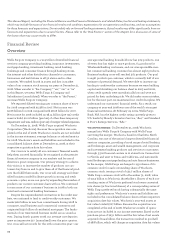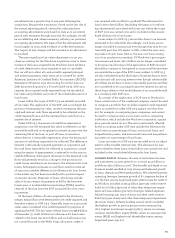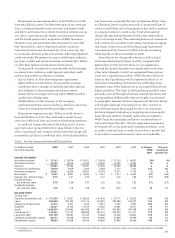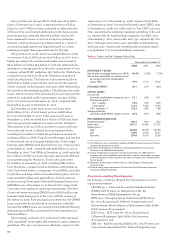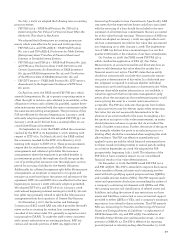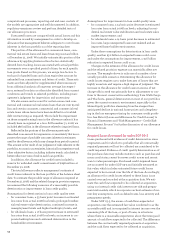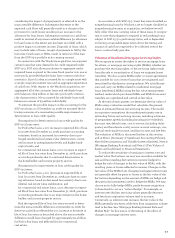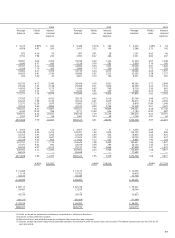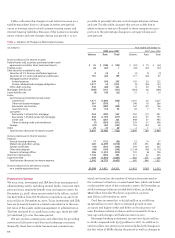Wells Fargo 2008 Annual Report Download - page 43
Download and view the complete annual report
Please find page 43 of the 2008 Wells Fargo annual report below. You can navigate through the pages in the report by either clicking on the pages listed below, or by using the keyword search tool below to find specific information within the annual report.
On February 20, 2008, the FASB issued FSP FAS No. 140-3,
Accounting for Transfers and Servicing of Financial Assets and
Extinguishments of Liabilities (FSP FAS 140-3). FSP FAS 140-3
requires that, if an entity transfers a loan to, and then subse-
quently executes a repurchase financing with the transferor
collateralized by that loan, then the transferor would not be
permitted to treat the initial transfer as a sale unless certain
criteria are met, including that the transferred asset must be
readily obtainable in the marketplace. The provisions of this
FSP are effective beginning January 1, 2009, and shall be
applied prospectively to initial transfers and repurchase
financings for which the initial transfer is executed on or
after this date. Early application is not permitted. FSP FAS
140-3 is not expected to have a material effect on our consoli-
dated financial results.
On March 19, 2008, the FASB issued FAS 161, Disclosures
about Derivative Instruments and Hedging Activities – an
amendment of FASB Statement No. 133 (FAS 161). FAS 161
changes the disclosure requirements for derivative instru-
ments and hedging activities. It requires enhanced disclo-
sures about how and why an entity uses derivatives, how
derivatives and related hedged items are accounted for, and
how derivatives and hedged items affect an entity’s financial
position, performance and cash flows. The provisions of FAS
161 are effective for financial statements issued for fiscal
years and interim periods beginning after November 15,
2008, with early adoption encouraged. Because FAS 161
amends only the disclosure requirements for derivative
instruments and hedged items, the adoption of FAS 161 will
not affect our consolidated financial results.
Our significant accounting policies (see Note 1 (Summary of
Significant Accounting Policies) to Financial Statements) are
fundamental to understanding our results of operations and
financial condition, because they require that we use esti-
mates and assumptions that may affect the value of our
assets or liabilities and financial results. Six of these policies
are critical because they require management to make diffi-
cult, subjective and complex judgments about matters that
are inherently uncertain and because it is likely that materially
different amounts would be reported under different condi-
tions or using different assumptions. These policies govern:
• the allowance for credit losses;
• acquired loans accounted for under SOP 03-3;
• the valuation of residential mortgage servicing rights
(MSRs);
• the fair valuation of financial instruments;
• pension accounting; and
• income taxes.
Management has reviewed and approved these critical
accounting policies and has discussed these policies with the
Audit and Examination Committee of the Company’s Board
of Directors.
Allowance for Credit Losses
The allowance for credit losses, which consists of the
allowance for loan losses and the reserve for unfunded credit
commitments, is management’s estimate of credit losses
inherent in the loan portfolio at the balance sheet date. We
have an established process, using several analytical tools
and benchmarks, to calculate a range of possible outcomes
and determine the adequacy of the allowance. The allowance
carried over from Wachovia was generally subject to the
same methodology described above. No single statistic or
measurement determines the adequacy of the allowance.
Loan recoveries and the provision for credit losses increase
the allowance, while loan charge-offs decrease the allowance.
PROCESS TO DETERMINE THE ADEQUACY OF THE ALLOWANCE
FOR CREDIT LOSSES While we attribute portions of the
allowance to specific loan categories as part of our analytical
process, the entire allowance is used to absorb credit losses
inherent in the total loan portfolio.
At December 31, 2008, the portion of the allowance for
credit losses estimated at a pooled level for consumer loans
and some segments of commercial small business loans was
$16.4 billion. For purposes of determining the allowance for
credit losses, we pool certain loans in our portfolio by product
type, primarily for the auto, credit card and real estate mortgage
portfolios. To achieve greater accuracy, we further segment
selected portfolios. As appropriate, the business groups may
attempt to achieve greater accuracy through segmentation by
sub-product, origination channel, vintage, loss type, geography
and other predictive characteristics. For example, credit cards
are segmented by origination channel and the Home Equity
portfolios are further segmented between liquidating and
nonliquidating. In the case of residential mortgages, we
segment the liquidating Pick-a-Pay portfolio, and further
segment this portfolio based on origination channel.
To measure losses inherent in consumer loans and some
commercial small business loans, we use loss models and
other quantitative, mathematical techniques to forecast losses.
Each business group forecasts losses for loans as of the bal-
ance sheet date over the estimated loss emergence period.
Each business group determines the model type and/or
segmentation method that fits the loss characteristics of its
portfolios and provides the greatest level of forecasting accu-
racy. We use both internally developed and vendor supplied
roll rate/net cash flow models. Roll rate/net cash flow models,
vintage base-models and behavior score models are often
used for near-term loss projections as well as time series/
statistical trend models for longer term projections. Models
are independently validated and are reviewed by corporate
credit personnel to ensure that the theory, assumptions, data,
Critical Accounting Policies





